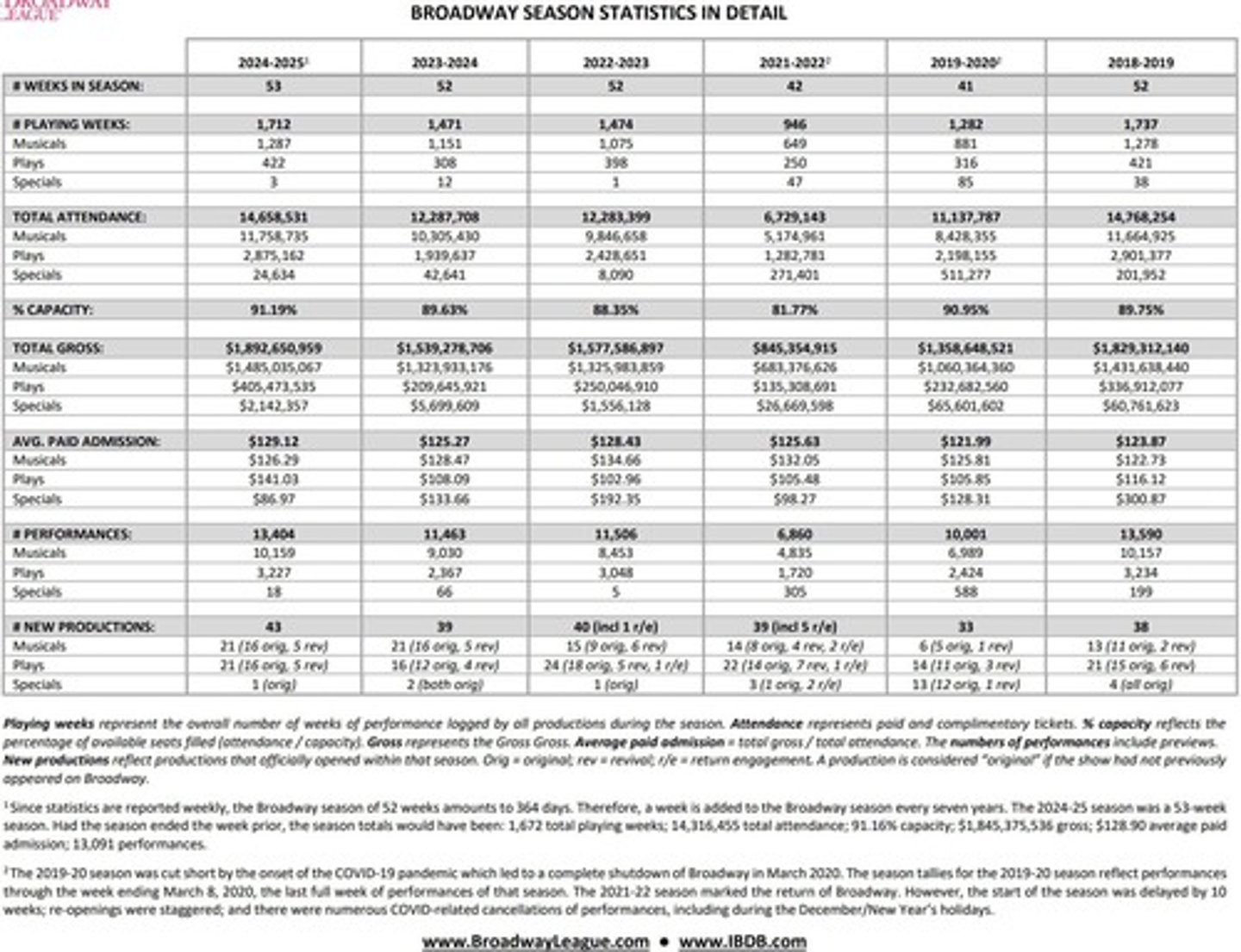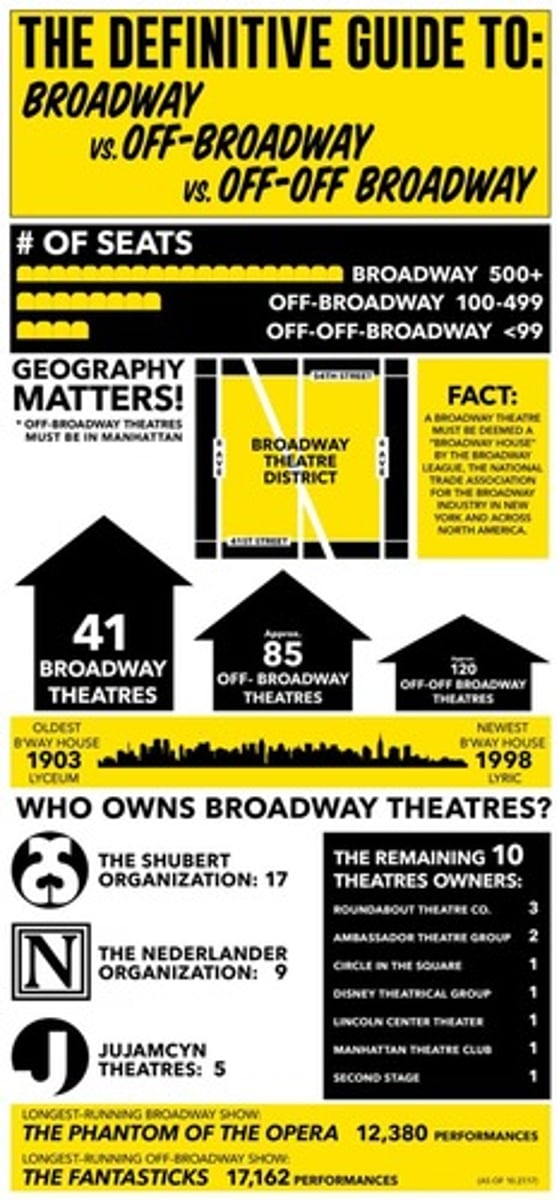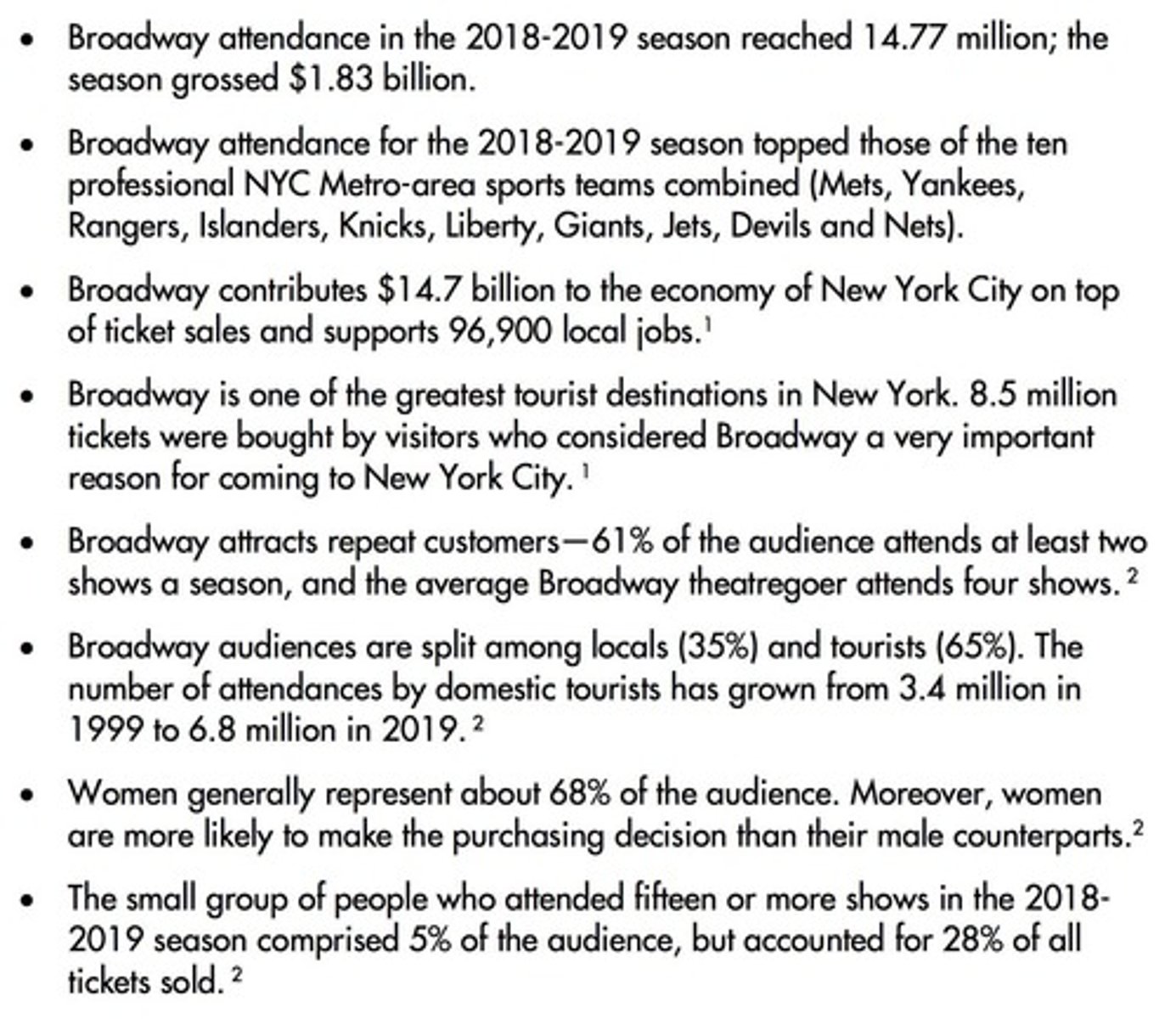Economics of Live Performing Arts: Costs, Output, and Market Structures
1/127
There's no tags or description
Looks like no tags are added yet.
Name | Mastery | Learn | Test | Matching | Spaced |
|---|
No study sessions yet.
128 Terms
What is the largest performing arts center under one roof?
The Denver Performing Arts Complex

What are the names of two resident organizations at the Denver Performing Arts Complex?
Opera Colorado and Colorado Ballet
What is a challenge in measuring output in service industries?
Defining satisfactory quantitative measurements
What are two examples of service industries where measuring output is challenging?
Banks and art museums
What are the four possible measures of output for a Live Performing Arts firm according to Throsby and Withers?
1) Number of Performances, 2) Number of Separate Productions, 3) Number of Tickets Available for Sale, 4) Number of Tickets Sold
Why is the number of performances a significant measure of output?
A substantial part of product cost is incurred per performance, such as wages and rent.
What does the number of separate productions indicate about an LPA firm?
It indicates the variety of artistic experiences produced.
What is the formula for calculating the number of tickets available for sale?
(# of performances) x (house capacity)
What does the number of tickets sold measure?
The actual number of artistic experiences provided by a performance.
What is the significance of the 2018-19 Broadway season?
It was the highest grossing and best attended season in recorded history.

What are the three types of professional theatre venues in NYC?
Broadway theatres, Off-Broadway theatres, and Off-Off-Broadway theatres.

What characterizes Broadway theatres?
They have at least 500 seats and feature big-budget productions with well-known stars.
How many seats do Off-Broadway theatres typically have?
100-499 seats.
What is the typical seating capacity for Off-Off-Broadway theatres?
Less than 100 seats.
Name a successful musical that started Off-Broadway before moving to Broadway.
Rent
What is the longest-running musical in theatre history?
The Fantasticks
What is the economic impact analysis (EIA) used for?
To measure how much an event contributes to the local economy.
What is one type of price discrimination that Broadway theatres might use?
Dynamic pricing based on demand.
What is the significance of measuring quality in the arts?
Quality is essential but harder to assess than quantity.
What does the term 'paid admissions' refer to?
The actual number of tickets sold for performances.
What is a deficiency in measuring the number of performances?
It does not account for the number of artistic experiences per performance.
What is the relationship between the number of productions and costs?
Costs vary directly with the number of productions as well as the number of performances.
What is the role of quality proxies in measuring artistic output?
They are used when direct measurement of quality is not possible.
What is one challenge of measuring output in the performing arts?
The difficulty in quantifying artistic experiences.
What is the impact of the Denver Performing Arts Complex's size?
It allows for a diverse range of performances and events.
What is the significance of the number of tickets sold in terms of demand?
It reflects the actual audience engagement and interest in performances.
What is the economic significance of Broadway theatre to New York City?
It contributes significantly to the local economy through tourism and employment.

What is the primary distinction between Broadway and Off-Broadway shows?
Broadway shows are typically more elaborate productions located on Broadway, while Off-Broadway shows are smaller and can be located anywhere in New York.
What are Off-Off-Broadway shows?
Off-Off-Broadway shows are smaller productions that can be found throughout New York City, often with less than 100 seats.
What are fixed costs in the context of theatre production?
Fixed costs are expenses that do not vary with the level of output in the short run, such as scenery, costumes, rehearsal wages, and theater rental.
What are variable costs in theatre production?
Variable costs change with the level of output and include salaries of actors, wages of stagehands, and ongoing advertising expenses.
What is the formula for total costs in theatre production?
Total Costs (CQ) = Fixed Costs (F) + Variable Costs (V) multiplied by Quantity (Q).
What is the significance of the preopening production cost?
Preopening production costs are fixed costs incurred before a play opens and are not affected by the length of its run.
What are some examples of Broadway shows produced during the 1960s?
Examples include Bye Bye Birdie, Cabaret, Camelot, Hair, and Fiddler on the Roof.
How does the average total cost (ATC) relate to fixed and variable costs?
Average Total Cost (ATC) is the sum of Average Fixed Cost (AFC) and Average Variable Cost (AVC).
What is the relationship between fixed costs and variable costs in Broadway productions?
Fixed costs can be significantly higher than variable costs, often estimated as 4 to 30 times the variable costs depending on the production scale.
What is the impact of the length of a show's run on variable costs?
Variable costs are closely related to the number of performances, as they accrue with each show after opening night.
What economic factors do performing arts firms consider when making production choices?
They consider consumer demand, production costs, market structure, and their artistic and financial objectives.
What is the law of diminishing returns, and how does it apply to performing arts?
The law of diminishing returns states that adding more variable inputs to fixed inputs will eventually yield lower per-unit returns; however, in performing arts, this does not apply as performances are repetitions of the same process.
What are the main types of market structures that performing arts firms operate in?
They operate in various market structures including perfect competition, monopoly, monopolistic competition, and oligopoly.
What role do government subsidies play in the performing arts?
Government subsidies can help performing arts firms cover costs and potentially allow them to lower ticket prices.
What is the average weekly overhead cost for a Broadway musical as of 2016?
The average weekly overhead cost ranged from $0.645 million, depending on the upfront investment.

What is the difference between commercial and non-profit theatre firms?
Commercial firms aim for profit, while non-profit firms focus on artistic objectives and may rely on donations and grants.
How do fixed costs influence the pricing strategy of a theatrical production?
High fixed costs necessitate sufficient box office receipts to cover these expenses and yield profit.
What are the implications of a declining average fixed cost (AFC) in performing arts?
A declining AFC suggests that spreading overhead costs over more performances can reduce the average cost per show.
What is the significance of the term 'setting up costs' in theatre production?
'Setting up costs' refer to the fixed costs incurred before a production opens, which are essential for the initial setup.
What is the average variable cost (AVC) in the context of live performing arts?
Average Variable Cost (AVC) refers to the costs that vary with the number of performances, such as actor salaries and operational expenses.
What factors can affect consumer demand for theatre productions?
Factors include price, income levels, availability of substitutes, and audience tastes.
What are the assumptions of Perfect Competition (PC)?
Many buyers and sellers, homogeneous products, free entry/exit, and no externalities.
What is the optimal outcome of Perfect Competition?
Goods are produced to satisfy consumer preferences at the least possible economic cost.
Why do no markets in the LPAs fit Perfect Competition?
The number of sellers is never large enough, and goods are differentiated.
What characterizes a Monopoly?
Only one seller controls the market and can choose the price-quantity combination along the demand curve.
Can a monopolist force consumers to buy at high prices?
No, the demand curve dictates the quantity that can be sold at any chosen price.
What is Monopolistic Competition (MoCo)?
A market structure blending elements of monopoly and competition, featuring many sellers with differentiated products.
How does Monopolistic Competition apply to Broadway theater?
Each show has a monopoly over its own production while competing with others for audience.
What defines an Oligopoly?
A market dominated by a few large firms, which may produce either homogeneous or heterogeneous products.
How do firms in an Oligopoly make pricing decisions?
They consider the probable responses of other firms to their pricing strategies.
Why might the performing arts market appear to be an Oligopoly?
A few large institutions dominate the market, such as symphony orchestras and opera companies.
What is the primary objective of a commercial LPA firm?
To maximize profit.
What are the quality objectives for not-for-profit LPA firms?
To offer performances that satisfy their standards of excellence and choose a diverse repertoire.
What does the term 'diminishing returns' refer to in the context of LPA firms?
The phenomenon where increasing one input while holding others constant yields smaller increments to quality.
What is the 'Bang for the Buck' condition?
It equalizes marginal product per dollar spent across different inputs.
What is the quantitative goal of not-for-profit LPA firms?
To make their product available to as large an audience as possible.
What motivates not-for-profit LPA practitioners?
A belief that art is intrinsically good and socially necessary, leading them to seek wider audiences.
What is a crucial characteristic of Monopolistic Competition?
There are enough sellers that each assumes their pricing decisions will not provoke reactions from others.
What is an example of a market that exhibits Monopolistic Competition?
The Broadway theater industry.
How do performing arts firms balance quality and cost?
By choosing inputs to produce a desired level of quality as economically as possible.
What is the role of competition among firms in Monopolistic Competition?
Firms compete by offering products that are unique but closely substitutable.
How does the performing arts industry differ from typical oligopolies?
Many performing arts firms operate as non-profits and do not engage in competitive pricing strategies.
What is the impact of public regulation on monopolies?
It can interfere with the monopolist's ability to set prices and quantities.
What is the significance of the number of sellers in a market structure?
It influences the level of competition and market power within the industry.
How do performing arts firms determine their pricing strategies?
Based on their market position and the uniqueness of their offerings.
What is the relationship between quality and cost in LPA firms?
Quality decisions require balancing inputs to achieve the desired artistic standards economically.
What is a key challenge for not-for-profit LPA firms?
Attracting a large audience while maintaining artistic quality.
What must revenues cover for a performing arts enterprise to survive?
Revenues must cover costs in the long run.
What is the primary motivation of a nonprofit performing arts enterprise?
To maximize attendance while maintaining quality standards.
What are the primary sources of revenue for nonprofit performing arts organizations?
Government subsidies and private charitable donations.
What does the term 'available seats' refer to in the context of performing arts?
The number of performances multiplied by house capacity.
How is demand for tickets expressed in the performing arts?
In terms of the number of seats sold at any given price.
What is the significance of the assumption that the house is sold out for every performance?
It allows for the determination of the length of the run and total attendance.
What is the objective of a commercial Broadway theatre?
To maximize profit by finding the optimal price and quantity of seats sold.
What does MR=MC signify in the context of a performing arts production?
It indicates the most profitable price point where the revenue from the last unit sold equals its cost.
What happens to average cost per seat as output increases in the performing arts?
Average cost per seat falls continuously as fixed costs are spread over more performances.
What is price discrimination in the context of performing arts?
Charging different prices to customers based on their willingness to pay over time.
What is the primary goal of a nonprofit theatre regarding ticket pricing?
To set prices that cover average total costs (P=ATC).
How does total attendance differ between nonprofit and commercial theatres?
Total attendance is typically greater in nonprofit organizations due to lower ticket prices.
What does the length of season refer to in nonprofit theatre?
The total number of performances across multiple productions rather than individual runs.
What is the relationship between subscription sales and nonprofit performing arts programs?
Subscription sales account for a significant fraction of admissions.
How does increased popularity affect the demand curve for a performing arts company?
It shifts the demand curve to the right, indicating increased ticket sales.
What is the impact of fixed costs on average fixed cost (AFC) as the season length grows?
AFC declines as total fixed costs are spread over a larger quantity of performances.
What does AVC and MC refer to in the context of nonprofit theatre?
Average variable cost and marginal cost averaged over the season's repertory.
What is the significance of the intersection of demand and ATC in nonprofit theatre?
It indicates the price at which total attendance is maximized while covering costs.
What is the role of government subsidies in nonprofit performing arts?
They provide essential funding to help cover operational costs.
What does the term 'repertoire' refer to in nonprofit performing arts?
The performance of various plays, operas, or ballets by a company at regular intervals.
What happens to the average cost per seat as the number of performances increases?
It decreases due to the spreading of fixed costs.
What is the implication of a 'hit' show in commercial theatre?
It indicates strong demand, allowing the production to earn back costs and generate profit.
What is the outcome for a 'flop' show in commercial theatre?
Demand rests below average total cost, resulting in no break-even point.
What is the effect of extending a play's run through price reductions?
It can increase profitability by selling more seats at lower prices.
How do nonprofit organizations typically approach production planning?
They often plan a repertory of multiple productions rather than focusing on single shows.
What does the term 'length of run' refer to?
The duration a particular production is performed.